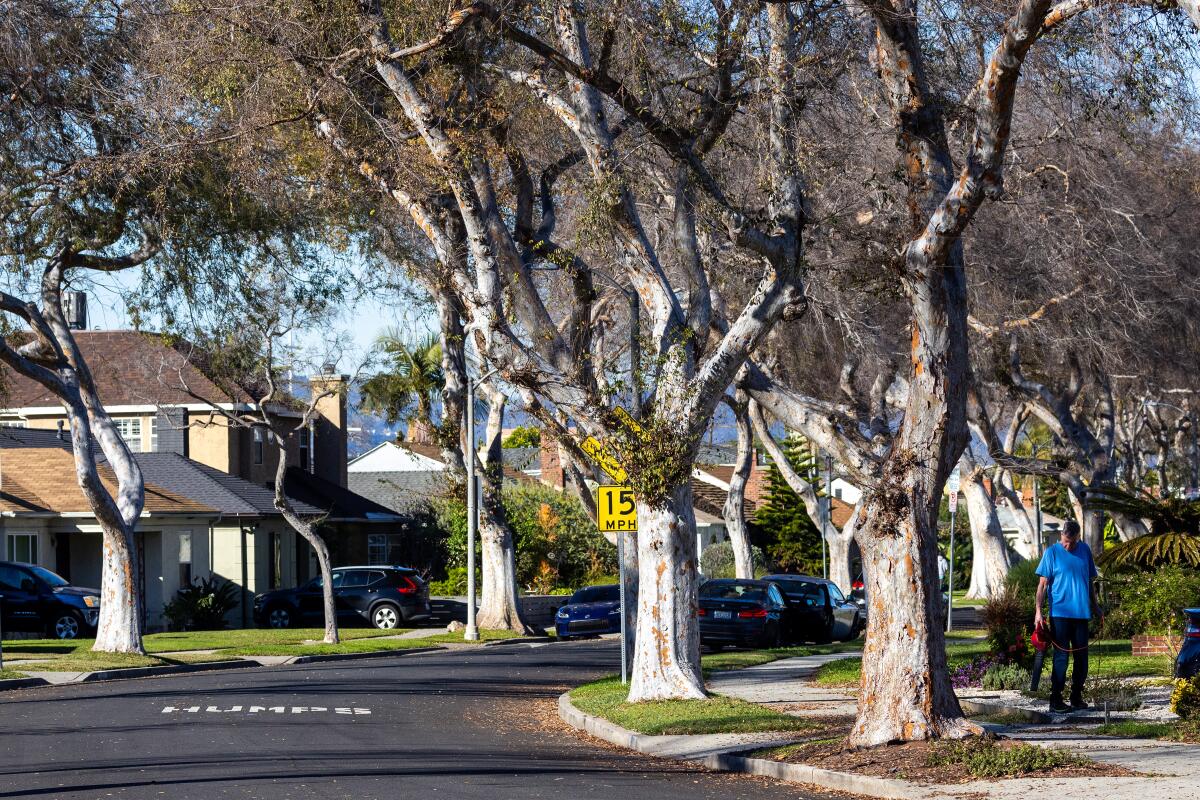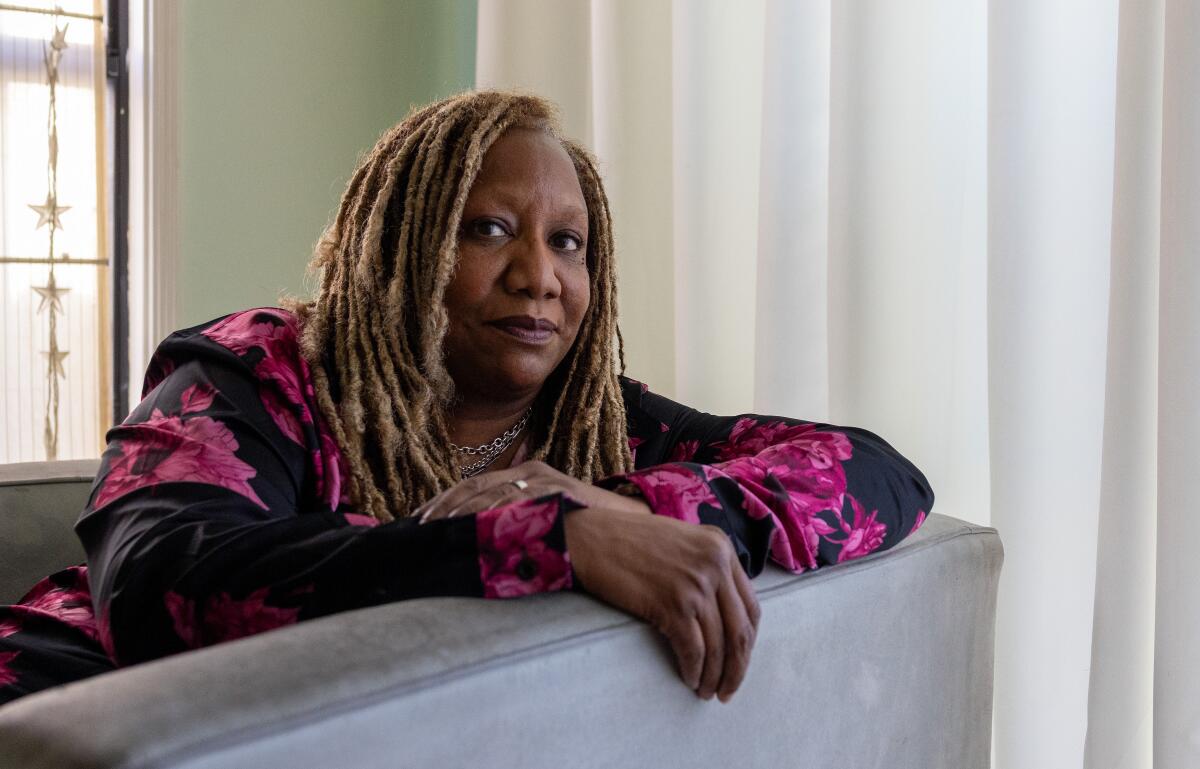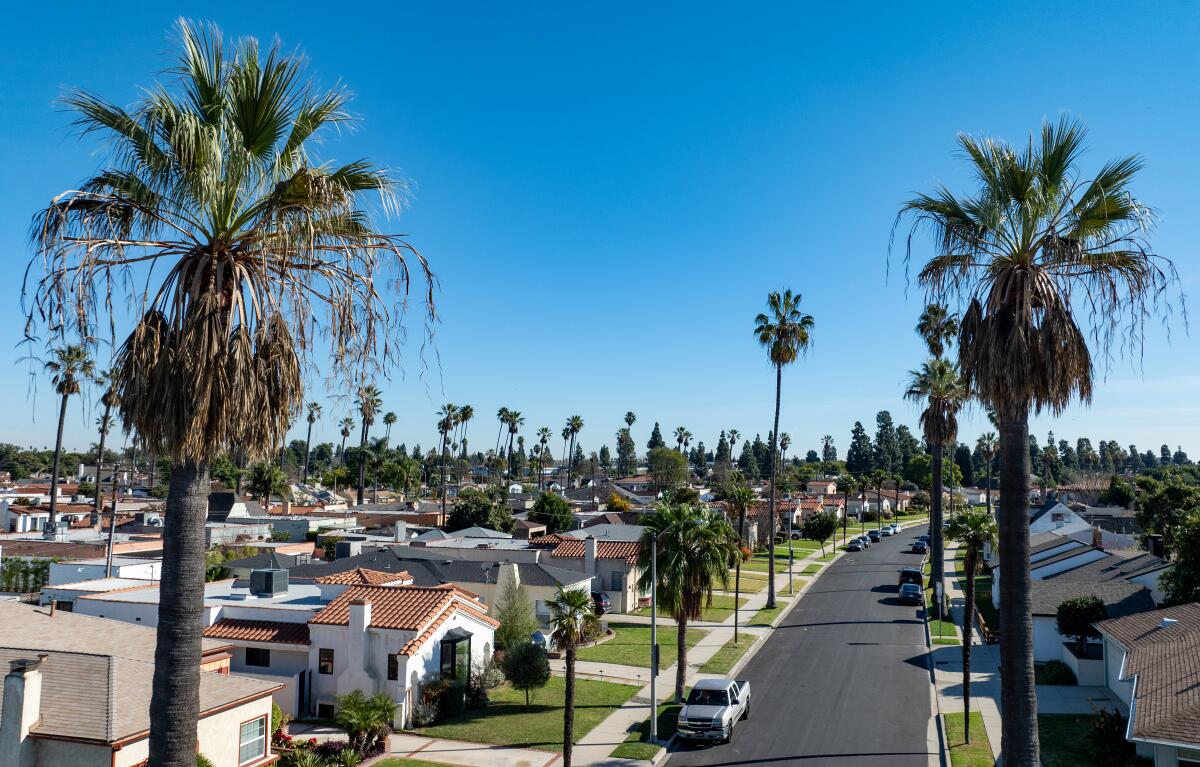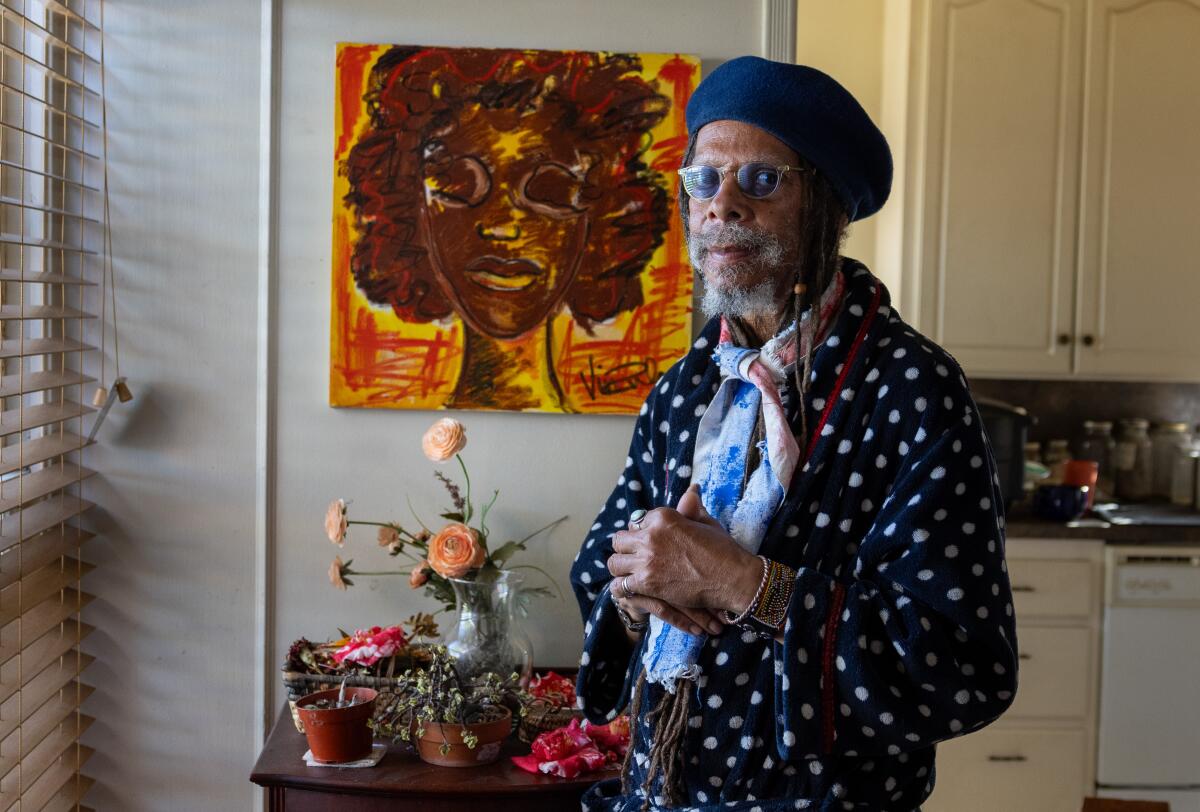Do you want to sell your house? In historically Black Leimert Park, the question triggers fear and anger

- Share via
The phone calls came weekly, from people Gwendolyn Jones didn’t know, asking for something she doesn’t want to give.
Frustrated, the 74-year-old Leimert Park resident stopped answering calls from unknown numbers on her cellphone and late last year canceled her home phone, not wanting another conversation with a stranger asking if she’ll sell the house she’s lived in since 2008.
In the last decade, investors and home buyers from outside the area have poured into Leimert Park, driving up prices and irritating some residents concerned about the gentrification of the historic Black neighborhood — and their peace of mind.
Jones said it’s not just phone calls, but also letters and knocks at the door.
“It’s just disturbing,” she said.
To some extent, such pitches occur all over Southern California, but Leimert Park residents said the inquiries reached a peak over the last few years as home prices soared and have generated fear that some people are being taken advantage of.
The South Los Angeles neighborhood has a high percentage of senior homeowners, and some residents worry that investors are making low-ball offers to people on fixed incomes or who may have fallen on hard times and are not aware what their homes are worth.
Jones said most of the offers she’s received for her house have been fair, at over $1 million, but two were for around $550,000.
“Why would you think I would be stupid enough to sell you my house for that?” Jones said.
Explore the latest prices for homes and rentals in and around Los Angeles.
According to residents, individuals making the inquiries sometimes say they are investors but more often identify themselves as real estate agents and could be working for themselves, a traditional home buyer or an investor looking to renovate and flip.

Gina Fields said some people claim to be her neighbor. In a recent voicemail message that the Leimert Park resident shared with The Times, someone who didn’t give his name identified himself as such, saying he wanted to buy her house — regardless of condition — so he could add to his rental portfolio in the area.
“He’s not my neighbor,” Fields said. “I know all my neighbors.”
When The Times called the investor’s number, the man who answered said he was busy and would call back, but he did not. He didn’t respond to a follow-up voicemail seeking comment.
A mini-industry lends a helping hand to such real estate professionals. Real estate software companies like PropertyRadar and PropStream enable investors and agents to search for homes that might have owners willing to sell, including those in default and senior citizens.
Another lead: houses whose owners recently died, perhaps leaving the property to a spouse or relative looking to move on.
Such companies provide tools to efficiently run a marketing campaign aimed at getting the homeowners to sell, with direct mail options, rapid phone dialing apps and more.
In the first nine months of last year, the typical ZIP Code with at least 100 home sales in L.A. County had 10% of those sales go to investors, according to data from real estate brokerage Redfin. In the two ZIP Codes covering Leimert Park, the percentages were 25% and 26%.
Real estate agents said investors target Leimert Park because they can renovate older, relatively spacious homes for modern tastes and offer them at a significantly lower price than homes just a few miles west in Culver City or Mar Vista, for example.

Part of a master plan developed from the 1920s to the 1940s on what was then considered the Westside, the neighborhood has the feel of a suburban enclave, with stately trees and pristine lawns framing well-kept Spanish Colonials and Minimal Traditionals.
The neighborhood sits between two of the region’s largest employment centers — downtown Los Angeles and the farther west Westside of today. Along with some adjacent Crenshaw communities, it has long been a bastion of the Black middle class, who have used their homes to build generational wealth.
But in the last decade, home buyers priced out of other L.A. neighborhoods moved in, attracted not only by the lower price point but also new light rail lines and restaurants. Investors have lured newcomers with renovated homes that, on the high end, now fetch more than $1.5 million. Farther west, a remodeled house might top $2 million.
Since 2015, average single-family home prices across L.A. County have risen 89%, according to Zillow. During the same time, values more than doubled in Leimert Park, climbing 132% from $413,857 to an average of $960,708 in December.
Many recent Leimert Park buyers are white and, given rising home prices and the nation’s economic disparities, some longtime Black residents worry they’ll lose a Black cultural center that they and others built after beating racist real estate practices that once kept people like them out.
To move here and to other Crenshaw District neighborhoods in the 1940s and ’50s, African Americans battled racial covenants, lawsuits and violence. In 1951, the Cadwell family moved into a home on 6th Avenue and woke up to a burning cross on their lawn, according to the book “L.A. City Limits: African American Los Angeles From the Great Depression to the Present.” Some people, like the city’s first African American mayor, Tom Bradley, bought homes through white intermediaries.
“It was a long struggle,” said historian Jennifer Mandel, author of “The Coveted Westside: How the Black Homeowners’ Rights Movement Shaped Modern Los Angeles.” “It went across generations.”
For some, the potential loss of Black community in Leimert Park is compounded by the fact that the city’s Black population has been on the decline since the 1980s as many families left for cheaper neighborhoods in the Inland Empire and beyond.
“We are inclusive,” said Fields, a manager at a law firm who is active in the community. “But this is the last, long-standing African American area in Los Angeles. We want to maintain that.”
The South L.A. neighborhood is being remade as a Black-owned corridor for culture. But last week’s chaotic Juneteenth festival shows it won’t be easy.
Real estate agents and investors have long pounded the pavement searching for homes to buy and sell, at times playing on racial prejudice.
In post-war America, agents commonly engaged in a practice known as blockbusting, in which they persuaded white homeowners to sell low based on fears that Black people were moving into a neighborhood, contributing to so-called white flight. Once in control of the properties, agents sold them to Black families at inflated prices.
Mandel said the practice, with some variations, occurred in Leimert Park and surrounding neighborhoods, mostly after the Supreme Court in 1948 ruled racially restrictive covenants unenforceable.
Fields, who also serves as chair of the local neighborhood council, said some longtime Black homeowners see today’s deluge of calls, fliers and door knocks — occurring at a time of demographic change — as a modern twist on blockbusting, in which investors and agents want them to sell so they can flip the home at a higher price for incoming white families.
“Even if people are getting what might be considered a fair price for what the market is right now — to most people in the neighborhood, because of the history, it still feels predatory,” Fields said.
“A lot of older people certainly have a fear that they want to push African Americans out of Los Angeles altogether.
Today, technology makes it easier than ever to find homeowners who may be inclined to sell.
Using a free trial of the service PropertyRadar, an L.A. Times reporter drew a line around the boundaries of Leimert Park and found just over 1,000 single-family houses owned by people 65 and older who had more than 30% in equity.
Using a provided PropertyRadar filter, The Times then found nine high-equity, senior-owned homes where one owner — presumably a partner or another family member — recently died.
“The remaining owner may be motivated to sell, whether to downsize or to get a fresh start in another property,” a PropertyRadar prompt said when applying the filter for “death of joint tenant.”
The list of homes contained owner names and the estimated amount of equity. A user could also access owner phone numbers and emails and, for an additional fee, software to rapidly text and call the owners.
One homeowner on the list said she wished people would stop sending her fliers, but declined to talk further.

VinZula Kara, a 68-year-old artist, said his house probably appeared on the list because his mother passed away about a year ago and left the home she bought in 1996 to Kara and his siblings.
He said the fact that his house appeared on a list for people potentially motivated to sell was “creepy” and an invasion of privacy.
Kara said he moved into the house about a decade ago to care for his mother and he isn’t interested in selling now that he is a co-owner. His mother wasn’t either.
Sitting at his dining room table, Kara mimicked his mom’s reaction to fliers, slamming his hand on the table.
“Like old-fashioned religion,” Kara said. “She didn’t want to sell her house — she felt she worked hard for this home.”
For his part, Kara said that when people come to the door to inquire about his house, it feels as if “someone is going to feed on you.”
“You always have to tell them to go,” he said.
Whether the people contacting residents are using real estate software is unclear. According to PropertyRadar, no person signed up for an account using the phone number of the investor who contacted Fields. In a statement, PropertyRadar Chief Executive Mark Hockridge said “predatory targeting of any property owner is completely unacceptable and there are numerous laws and regulations protecting people from such behavior.”
Hockridge said thousands of companies provide public record data to marketers and that PropertyRadar mandates clients agree to a “Good Neighborhood Marketing Pledge” that requires them to be “legal, honest and transparent” in their outreach. If consumers ask not to be contacted, clients must comply, according to the language.
“If a customer of ours has violated our pledge, we will investigate and may suspend or terminate their use of our services,” Hockridge said, adding that “generally, the connections made using PropertyRadar data are mutually beneficial” to both property owners and the businesses and organizations using the service.
PropStream, a similar data service, did not return a request for comment.
In Leimert Park, some residents, including Kara, said the sale inquiries seemed to have ebbed somewhat lately, coinciding with a slowdown in the housing market.
Not all longtime residents are bothered. Some brush off pitches they receive as easy to ignore.

Subscribers get exclusive access to this story
We’re offering L.A. Times subscribers special access to our best journalism. Thank you for your support.
Explore more Subscriber Exclusive content.
Rossanna Taylor, who bought her house in 1993, is among the unbothered. She also shared a unique perspective on how the requests make her feel.
“I think I am in demand,” she said on a recent afternoon, standing in the doorway of her 1941 home that Redfin values at nearly $1 million.
For others, the pitch isn’t comforting.
Johnnie Raines, 76, grew up in Leimert Park. He has owned his current home there since 2003 and is deeply involved in the community, including through volunteering at Audubon Middle School. Raines said he will pass his house down to his children.
“‘If I do decide to sell my home it won’t be with you because you bug me too much,’” is how he answers some inquiries, which can be as often as twice daily.
Raines said he thinks the pitches are motivated more by simple economics than race, but he added they are bothersome in part because African American families like his once fought to own homes in the neighborhood.
“This is important to my family — this is important to our soul,” Raines said. Real estate professionals “are not giving it any reverence.”
More to Read
Sign up for This Evening's Big Stories
Catch up on the day with the 7 biggest L.A. Times stories in your inbox every weekday evening.
You may occasionally receive promotional content from the Los Angeles Times.













